What is tennis elbow?
Tennis elbow is a tendon condition and is by far the most common cause of elbow pain encountered in musculoskeletal healthcare. It is often associated with repetitive overuse of the wrist extensor muscles of the forearm. The wrist extensor muscles form the bulk of the outer aspect of the forearm and attach, via a common tendon, to a bony protuberance (the lateral epicondyle) of the upper arm bone (the humerus). It is at the junction between the lateral epicondyle and the tendon that tennis elbow occurs (see image below).
Tennis elbow develops gradually over time, often without a preceding traumatic event. Repetitive overuse of the wrist extensor muscles causes the tendinous insertion of these muscles to become strained. When the common tendon of the wrist extensors is subjected to continued and repeated periods of stress it can become inflamed (an inflamed tendon is called tendinitis). Over time and in the presence of regular bouts of tendinitis the resultant healing response becomes compromised. A compromised healing process results in a weakened and painful tendon (this is known as tendinosis or tendinopathy).

Tennis elbow is characterised primarily by pain on the outside of the elbow, and successful treatment will address the specific underlying pathology, whether that be tendinitis or tendinosis/tendinopathy. An ultrasound scan is required to fully diagnose the underlying cause of your pain.
What are the treatment options available for tennis elbow?
Most tennis elbow cases can be successfully treated using a combination of activity modification, bracing, shockwave, physiotherapy, and rehabilitation exercises. However, in severe recalcitrant cases these conservative options might not be enough to manage your symptoms.
If you have tried conservative management but are still struggling with daily activities, work, or play then an ultrasound guided procedure may be indicated.
There are three ultrasound guided procedures that can be used to treat tennis elbow. The most appropriate treatment for you is dependent on the clinical assessment and the findings of a diagnostic ultrasound scan.
Treatment options include:
- Tendon fenestration (the focus of this blog).
- Corticosteroid injection.
- Hyaluronic acid injection.
How does ultrasound guided tendon fenestration work?
Fenestration is designed to stimulate tendon repair by producing a natural healing response. Its primary goal is to switch a chronic tendinopathic tendon into an acute condition, capable of responding with a revitalised healing process (Jacobson et al., 2015).
Soft tissue healing follows a specific, well documented pattern of biochemical events which is ultimately designed to remove damaged tissue and replace it with a new healthy counterpart.
The healing process starts when a tissue becomes injured, either by repetitive microtrauma (such as with repetitive stain type injuries) or after a specific traumatic event. Soft tissue healing starts with a short period of acute inflammation, lasting up to a few weeks (Jacobson et al., 2015). This initial healing phase produces an “inflammatory soup” which contains specific chemical mediators designed to remove damaged tissue and traumatic debris from the injury site. The inflammatory response is particularly painful for a reason – it stops you from damaging the injured tissue further by continuing to use it! After the acute inflammatory period has settled the body produces cells called growth factors which are responsible for the development of new tendon tissue (Molley et al., 2003). This is called the proliferation phase. Over time the new tissue is refined and remodelled (in the remodelling phase) enabling it to take on the function required of it (tensile strength in the case of a tendon).
If a tendon is repeatedly injured or strained the resulting repetitive healing processes that occur result in sub-optimal healing and ultimately a weakened and painful tendon.
An ultrasound guided tendon fenestration is a pro-inflammatory technique. This means it invites inflammation into the tendon to allow it to heal effectively. During fenestration a needle is repeatedly guided directly through the damaged tendon tissue. This process promotes localised bleeding, kickstarting the initial phase of the healing process, stimulating the development of healthy tendon tissue by initiating a healing response (Jacobson et al., 2015).
When is an ultrasound guided tendon fenestration appropriate and how is the procedure undertaken at Complete Injections?

At Complete all ultrasound guided procedures, including tendon fenestration, are undertaken using real time ultrasound imaging. This ensures that the intended structure is accurately targeted and treated in a safe and effective manner.
A comprehensive clinical assessment including a preliminary diagnostic ultrasound scan is preformed to identify and locate the source of your symptoms. When considering a tendon fenestration for chronic tennis elbow it is vitally important that the area of tendinopathy is located and targeted for the technique to have the best chance of success. Therefore, a tendon fenestration must be performed under ultrasound guidance.
If your clinician diagnoses a tendinopathy (wear and tear) rather than a tendinitis (inflammation) then an ultrasound guided tendon fenestration may be the most appropriate treatment option for you.
There is no corticosteroid included in an ultrasound guided tendon fenestration. Corticosteroids are used to reduce inflammation and therefore it is not indicated for a non-inflammatory condition such as tendinopathy. In fact, research strongly suggests that injecting corticosteroid for the treatment of tendinopathy of the elbow can make things worse in the long term (Housner et al., 2009).
An ultrasound guided tendon fenestration takes about two minutes to perform. Initially the outer elbow is anaesthetised using a short acting local anaesthetic (Lidocaine). This provides up to two hours of pain relief. Once the area has been successfully “numbed” a needle is introduced, under ultrasound guidance, directly into the area of tendinopathy. It is repeatedly passed through the area of the damaged tissue thereby disrupting its structure and stimulating a targeted healing response.
In most cases a single fenestration procedure is enough to treat the symptoms associated with chronic tennis elbow. However, in severe cases, a series of up to three procedures may be required to successfully resolve your symptoms. This can be discussed with your clinician and a treatment plan developed. The decision to repeat fenestration is dependent on the findings of your diagnostic ultrasound scan and the success of the initial fenestration procedure.
What should I expect after an ultrasound guided tendon fenestration?
Research has shown that ultrasound guided tendon fenestration for chronic tennis elbow can provide significant reductions in elbow pain (Housner et al., 2009; McShane et al., 2008).
As previously discussed, the aim of an ultrasound guided tendon fenestration is to target the area of damaged tendon to stimulate an acute healing response and provide the optimum environment for new healthy tendon tissue to grow.
Because an ultrasound guided tendon fenestration is a pro-inflammatory treatment it is often painful after the procedure. The inflammatory phase of the healing process typically lasts for a few weeks and with this so does the pain associated with inflammation. Therefore, after an ultrasound guided tendon fenestration a period of increased pain is normal and in fact expected.
To ensure the healing process can occur unencumbered it is important to refrain from taking anti-inflammatory medication or using ice during the first two weeks after fenestration as this could affect treatment outcomes (Jacobson et al., 2015).
An ultrasound guided tendon fenestration is designed to stimulate new healthy tendon tissue. However, it is not a stand-alone treatment for chronic tennis elbow. It is important to treat the underlying cause of your symptoms, and therefore it is necessary to undertake a course of physiotherapy in the weeks after a fenestration procedure to ensure the best outcome. This often involves strengthening the arm muscles to ensure symptoms do not return. Physiotherapy treatment can be discussed and arranged with your clinical specialist during your appointment.
For further information or to book an appointment, please contact us on 0207 482 3875 or email injections@complete-physio.co.uk.


